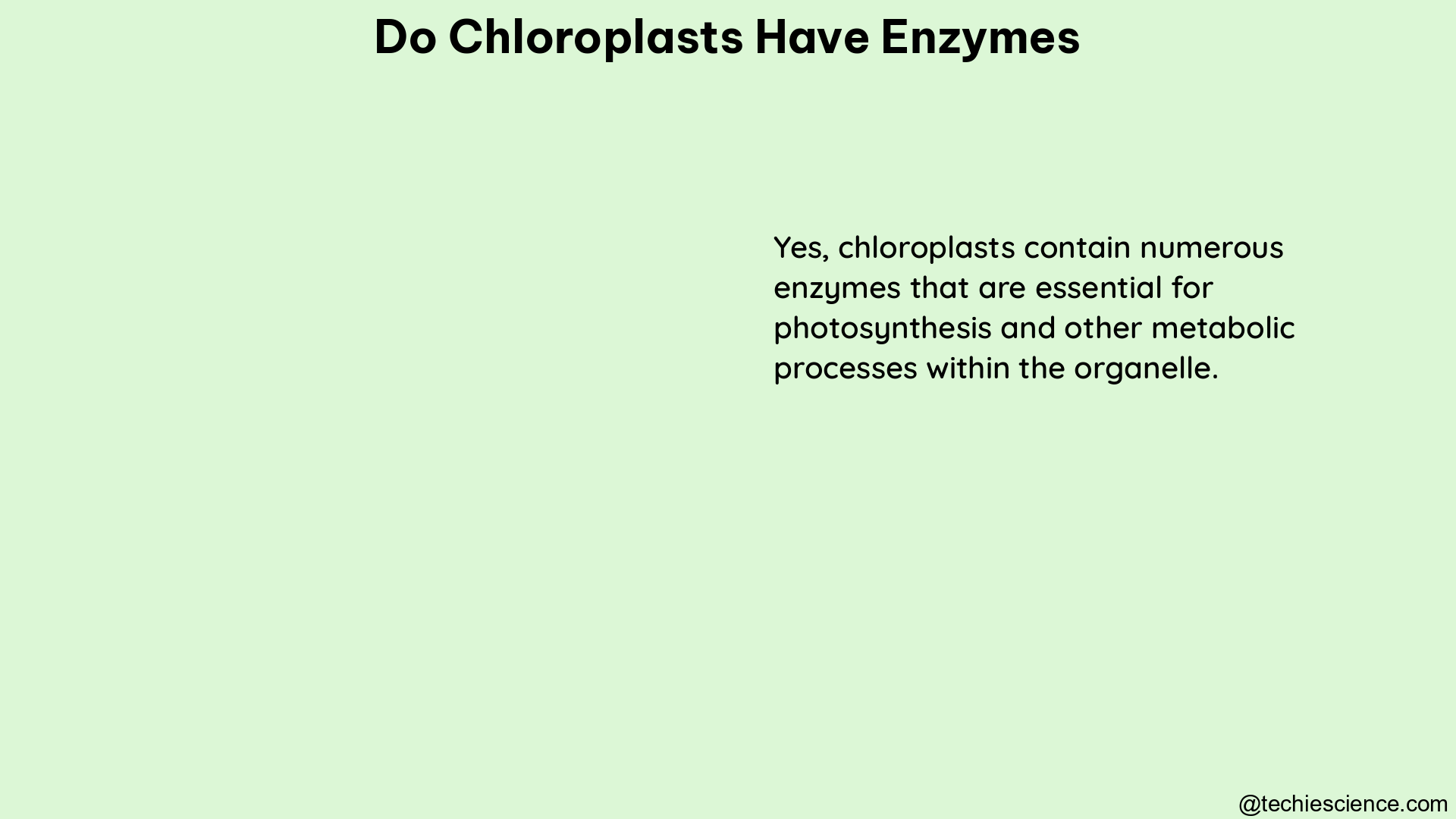Chloroplasts, the organelles responsible for photosynthesis in plant cells, are veritable hubs of enzymatic activity. These specialized structures contain a diverse array of enzymes that play crucial roles in various biochemical processes, from the light-dependent reactions of photosynthesis to the synthesis of essential organic compounds. In this comprehensive guide, we will delve into the world of chloroplast enzymes, exploring their functions, characteristics, and the techniques used to study them.
The Importance of Chloroplast Enzymes
Chloroplasts are the powerhouses of plant cells, converting light energy into chemical energy in the form of ATP and NADPH. This process is facilitated by a complex network of enzymes that orchestrate the intricate dance of photosynthesis. These enzymes are not only essential for the primary function of chloroplasts but also contribute to the overall metabolic and physiological well-being of the plant.
Key Enzymes Found in Chloroplasts

Rubisco: The Most Abundant Enzyme on Earth
One of the most prominent enzymes found in chloroplasts is Rubisco (Ribulose-1,5-bisphosphate carboxylase/oxygenase). This enzyme is a key player in the Calvin cycle, the process by which carbon dioxide is fixed into organic molecules during photosynthesis. Rubisco catalyzes the carboxylation of ribulose-1,5-bisphosphate (RuBP), the first major step in the Calvin cycle. Interestingly, Rubisco is considered the most abundant enzyme on Earth, with an estimated 10^9 tons of the enzyme present in the biosphere.
NADPH-dependent Dehydrogenases: Powering the Light-dependent Reactions
Another important group of enzymes found in chloroplasts are the NADPH-dependent dehydrogenases. These enzymes play a crucial role in the light-dependent reactions of photosynthesis, where they are responsible for the conversion of light energy into chemical energy in the form of ATP and NADPH. These high-energy molecules are then used in the Calvin cycle to fix carbon dioxide and synthesize organic compounds.
Enzymes Involved in Organic Compound Synthesis
Chloroplasts also contain enzymes involved in the synthesis of various organic compounds, such as amino acids, lipids, and carbohydrates. For example, the enzyme glutamine synthetase, which is involved in the assimilation of ammonia into organic compounds, is located within the chloroplasts.
Enzymes for Detoxification
In addition to their roles in photosynthesis and organic compound synthesis, chloroplasts also contain enzymes involved in the detoxification of reactive oxygen species (ROS), which are produced during photosynthesis. These enzymes include superoxide dismutase, catalase, and various peroxidases, which help to protect the chloroplasts from oxidative damage.
Quantitative Analysis of Chloroplast Enzymes
Researchers have employed various biochemical and molecular techniques to study the enzymes present in chloroplasts and their quantitative characteristics. These techniques include:
- Enzyme Assays: Measuring the activity and kinetic properties of specific enzymes within chloroplasts.
- Protein Gel Electrophoresis: Separating and identifying the different proteins, including enzymes, present in chloroplast extracts.
- Transcriptomic and Proteomic Analyses: Studying the expression levels of genes encoding chloroplast enzymes and the abundance of the corresponding proteins.
For example, a study by Shilo Rosenwasser et al. used 2D-based proteomics to characterize Arabidopsis plant lines overexpressing the AtPAP2 gene and T-DNA insertion lines. The researchers found that the observed boost in plant growth in the overexpressing lines was governed by the combination of higher photosynthetic efficiency and consumption of reducing equivalents in the mitochondria.
Conclusion
Chloroplasts are veritable powerhouses of enzymatic activity, housing a diverse array of enzymes that play crucial roles in various biochemical processes. From the light-dependent reactions of photosynthesis to the synthesis of organic compounds and the detoxification of reactive oxygen species, chloroplast enzymes are essential for the overall health and productivity of plant cells. By understanding the functions and characteristics of these enzymes, researchers can gain valuable insights into the intricate workings of chloroplasts and explore ways to optimize plant growth and productivity.
References:
- Chloroplast – an overview | ScienceDirect Topics: https://www.sciencedirect.com/topics/earth-and-planetary-sciences/chloroplast
- Chloroplast – an overview | ScienceDirect Topics: https://www.sciencedirect.com/topics/immunology-and-microbiology/chloroplast
- Modulating the activities of chloroplasts and mitochondria promotes growth and development: https://www.ncbi.nlm.nih.gov/pmc/articles/PMC10095973/

Hello, I am Piyali Das, pursuing my Post Graduation in Zoology from Calcutta University. I am very passionate on Academic Article writing. My aim is to explain complex things in simple way through my writings for the readers.